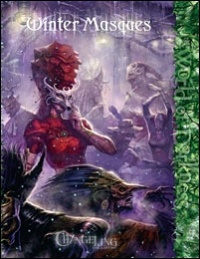Knighthood of the Dragonslayer
From Edge of Darkness Wiki
|
Winter Masques pp. 149-151 | |
| Wyrd | ●● |
|---|---|
| Preqs |
Wits + Composure dice pool of at least six dice Intimidation ●● |
| This box: view · talk | |
Saint George’s legacy lives on in the form of a noble order. The Knighthood of the Dragonslayer — or Ordem dos Cavaleiros Matadors de Dragão — still works today, but not necessarily in a militaristic capacity. While members are expected to have some martial prowess to their credit, what they really do is function as spies, interrogators and policemen. It is their job to kick over the rotting log from time to time to see what wretchedness crawls underneath. If what’s exposed cannot be abided, they do whatever must be done to either continue the disclosure or to end it where it lays. If this means torture, then it means torture. If it means threats against the innocent, then one must abide not by the individual but by the needs of the greater good. The Knighthood is very utilitarian in this way, and will do what it must to keep its freehold safe from treachery.
Mien
The changes brought on by joining the Knighthood of the Dragonslayer are subtle, and to some, almost unnoticeable. The first change is in the eyes: pupils shrink, and the whites of the eyes become stark and bloodless. Those who don’t note this change specifically still feel the amped intensity from a Knight’s unblinking stare. The second change is in the appearance of minor draconic features: a few black scales on the back of a hand, a few teeth turned to curved needles, a tongue starting to split at the tip like that of a snake. The party line explanation is that the founder was splashed with the blood of the True Fae “dragon” he destroyed, and this blood contaminated his mien with elements of that rough beast. Others, though, suggest that it is a sign of the corruption within the very heart of the order, a callous and reptilian leaning.
The Grand Cross of Saint George (Privilege)
Many knights of the order wear this cross — cobbled together from gems, seeds, bits of glass and other debris found in the Hedge — as part of a sash badge worn across the chest, though many simply pin it to a shirt or jacket. When activated and pressed against the skin of another, the cross is said to sense the sin within that person’s heart. The cross burns the skin provided that the target’s Morality score (or its equivalent, be it Clarity, Harmony, Humanity or Wisdom) is at 5 or below. For every one below 5, the cross does an additional point of lethal damage (Morality 5 causes one lethal, Morality 4 causes two lethal and so forth to a maximum of five lethal damage). In addition, one can heal the injury, but the cross leaves a permanent plus-shaped scar upon the flesh. If pressed against the flesh of someone with Morality 6 or higher, the cross has no effect (other than to tell the wielder that the victim may not be quite the sinner one suspected).
Action: Instant
Mien: The cross appears like an ugly, poorly crafted badge of flawed stones and bits of smooth glass (hemmed in by rings of dirty pewter). When active, though, the badge glows and throbs with an inner light that shines out through the multi-faceted stones and bits of glass to create a colorful display. When pressed upon the flesh of a sinner, the cross smolders and hisses.
Drawback: If used on a target with a Morality (or equivalent) score of 6 or 7, the knight feels dizzied and fatigued for the remainder of the scene, suffering a –1 penalty to all rolls. If the target had a Morality of 8 or 9, the penalty increases to –2, and if the target had a rare Morality 10, the penalty jumps to a dangerous –5 (penance, apparently, for testing the faith of someone who is clearly sacrosanct).
Catch: The token burns the hand of the user as well as (potentially) the flesh of the victim. This causes one point of lethal damage to the wielder. It doesn’t, however, cause a permanent scar — once the wound is healed, the scar will fade
Joining
The Knighthood welcomes new changelings with open arms. Certainly it tests them. The Dragonslayers examine every piece of a neophyte’s life, sifting through the remains of his mortal life, taking a close look at the fetch, drawing out the terrible dreams of one’s durance to ensure that the changeling doesn’t still secretly harbor hidden puppet strings that connect him to his Keeper.
One interesting factor regarding new members it that, if the knights are able to extract a confession of treason from a changeling, they might offer that traitor a second life within the group. Traitors aren’t given a free pass, of course, and unlike other knights, traitors are scrutinized for many years to ensure that their duplicitous ways are burned out of them, but it allows them to forestall their executions. And, many such “second-chance” changelings end up being the Knighthood’s most zealous members.
| |||||||||||||||||||
